Steel Markets

Construction Put in Place Data for May
Written by Peter Wright
July 7, 2020
Construction expenditures continued to show a positive but slowing year-over-year growth in May of 1.4 percent, non-seasonally adjusted. Because of the momentum that exists in most construction projects, steel consumption is likely to decline more slowly in building than in manufacturing.
Steel Market Update analyzes Commerce Department Construction Put In Place (CPIP) data to provide a detailed description of activity that accounts for about 45 percent of total U.S. steel consumption. See the end of this report for more information on this analysis.
Total Construction
Total construction expanded by 1.4 percent in three months through May and by 4.4 percent in 12 months through May, both year over year. Since the three-month growth rate is lower than the 12-month rate, momentum was negative in May. Construction activity is responding much more slowly than manufacturing to the COVID-19 situation due to project commitments. In May, construction expenditures totaled $98.4 billion. This breaks down to $68.1 billion of private work, $28.2 billion of state and locally funded (S&L) work, and $2.0 billion of federally funded work (Table 1).
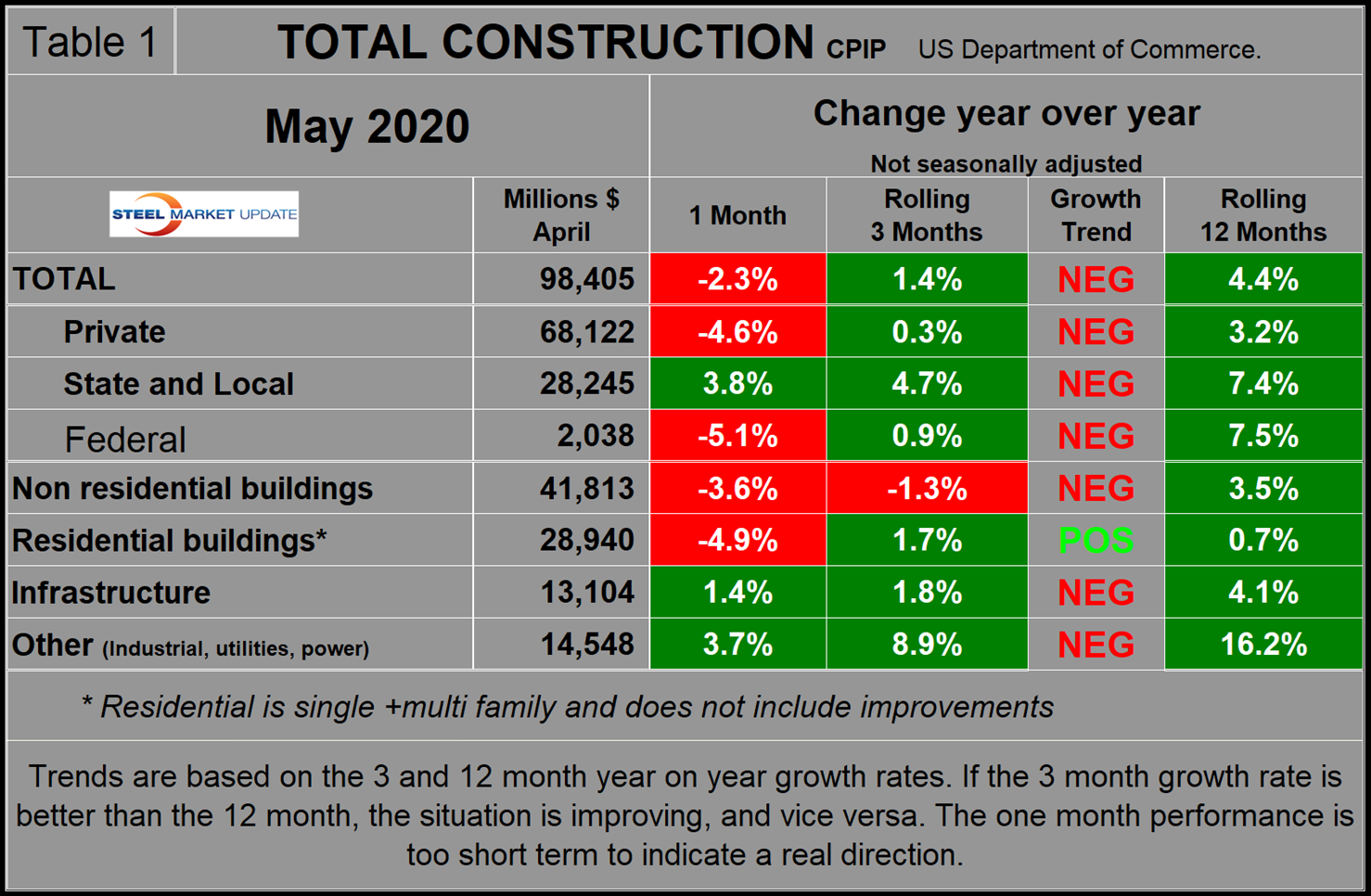
Figure 1 shows total construction expenditures on a rolling 12-month basis as the blue line and the rolling three-month year-over-year growth rate as the brown bars. Total construction was at an all-time high in the single month of August last year. On the rolling 12-months basis shown in Figure 1 the peak was in April 2020. Expenditures increased in three months through March, April and May, but by less than the seasonal norm in each case. The brown bars show growth on a 3MMA basis year over year. Growth slowed from 8.1 percent in February to 1.4 percent in May and is likely to become negative in the June data. In 12 months through May 2020, construction expenditures totaled $1.198 trillion. (This number excludes residential improvements; see explanation below.) To put that number in perspective, the pre-recession peak of total construction on a rolling 12-month basis was $1.028 trillion through September 2006. The low point was $665.1 billion in the 12 months through October 2011.
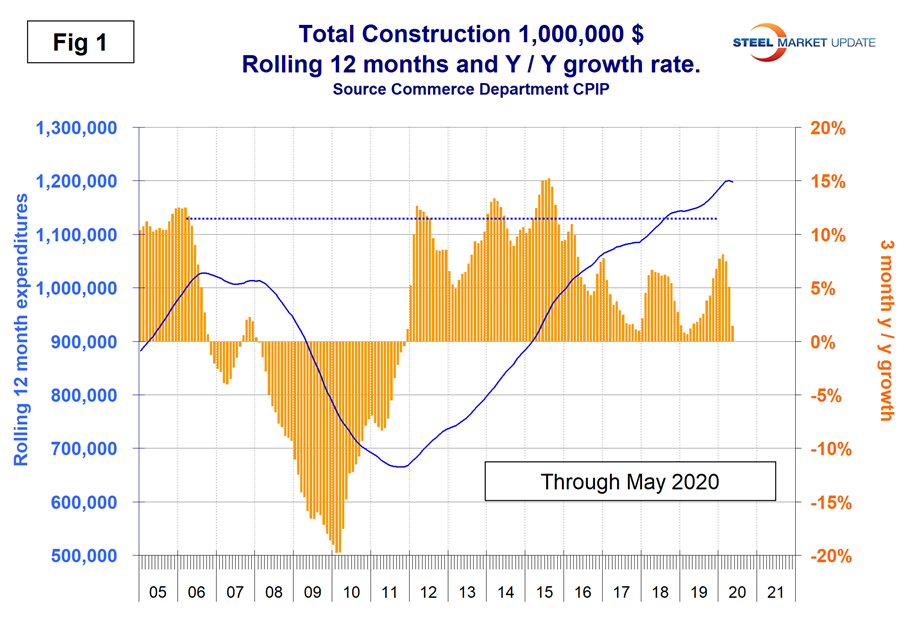
Figures 1, 2, 6, 7 and 9 in this analysis have the same format, the result of which is to smooth out variation and eliminate seasonality. We consider four sectors within total construction: nonresidential, residential, infrastructure and other. The latter is a catchall and includes industrial, utilities and power.
Private Construction
Table 2 shows the breakdown of private expenditures into residential and nonresidential and subsectors of both. The growth rate of private construction in three months through May was positive 0.3 percent, down from 7.3 percent in three months through February as shown by the brown bars in Figure 2.
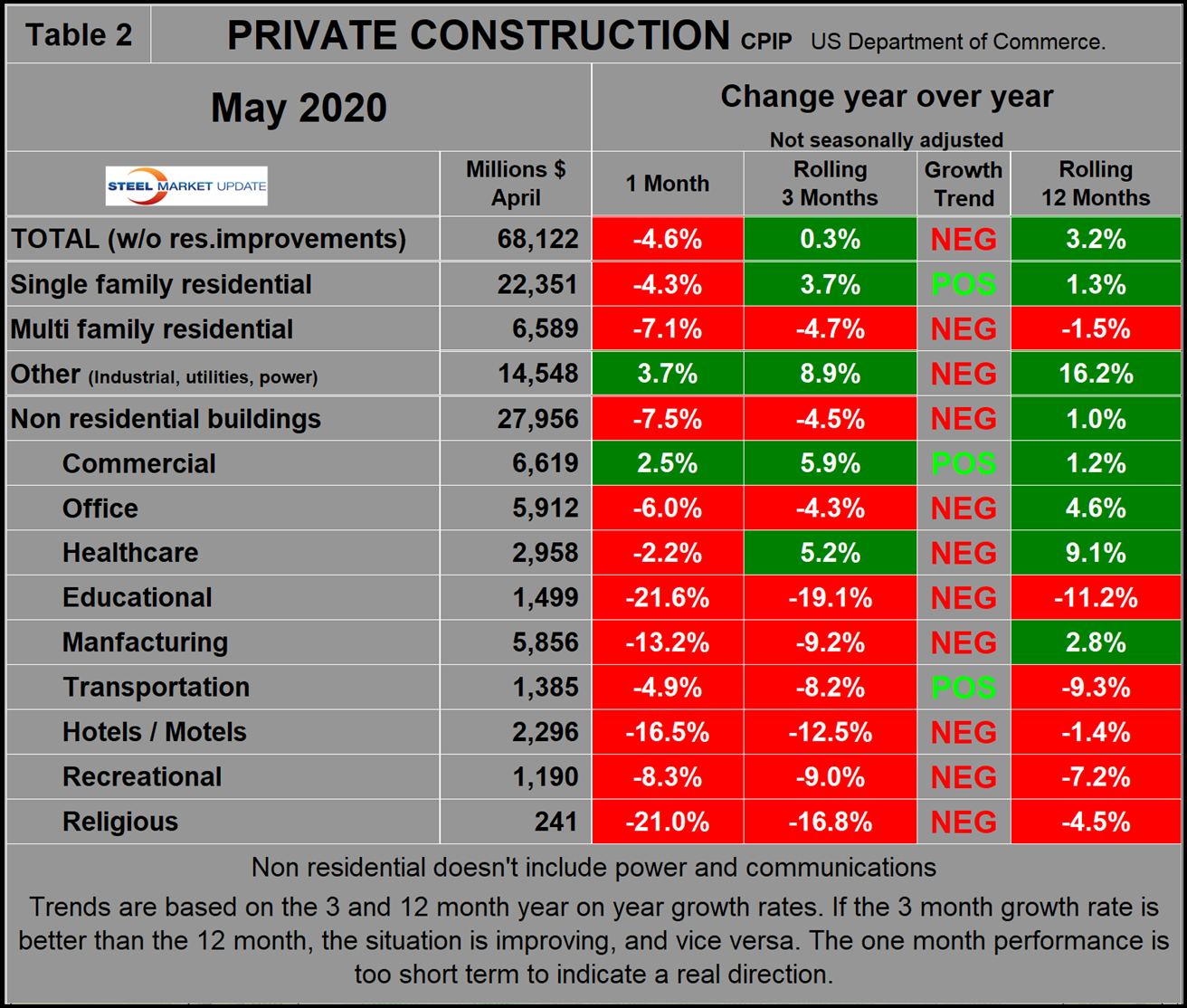
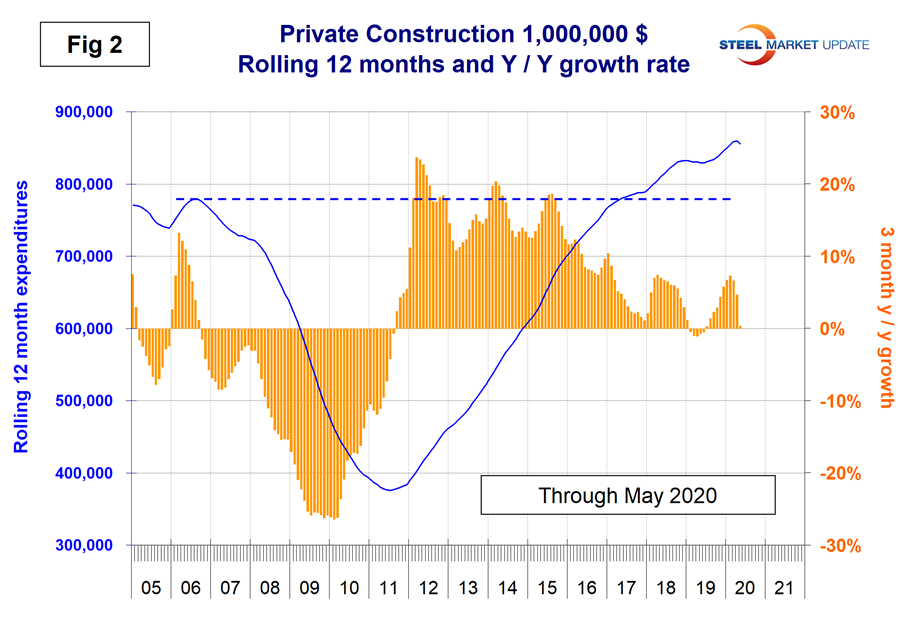
Within the private construction sector, the overall positive growth was driven mainly by single-family residential and the catchall of industrial, utilities and power. Nonresidential buildings in total were down by 4.5 percent with two positive sectors and seven negative.
Excluding property improvements, single-family residential expanded by 3.7 percent in three months through May with positive momentum and multifamily residential contracted by 4.7 percent with negative momentum. The CPIP data that is the main focus of this report is based on spending work as it proceeds; the value of a project is spread out from the project’s start to its completion. The Census Bureau reports separately on construction starts, entering the whole project into the database when ground is broken. Total housing starts contracted by 14.9 percent in three months through May year over year, the first negative growth since June last year. In three months through May, single and multifamily starts declined by 11.5 percent and 22.0 percent, respectively. Figure 3 shows the growth of both housing sectors since May 2005.
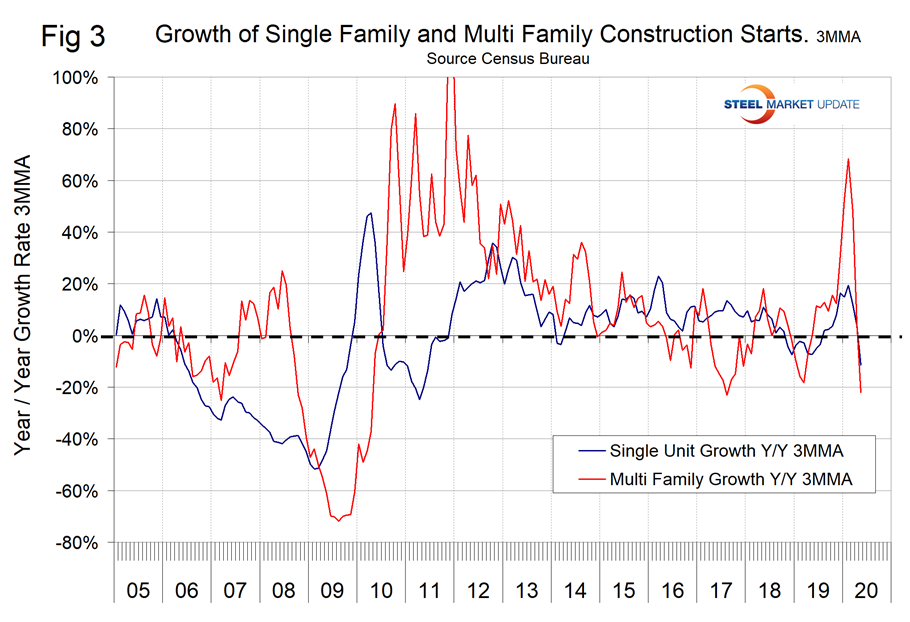
Figure 4 shows the ratio of single-family to multifamily starts. The proportion of single-family gradually increased from May 2015 when the ratio was 1.66 in favor of single units to 2.43 in May 2020.
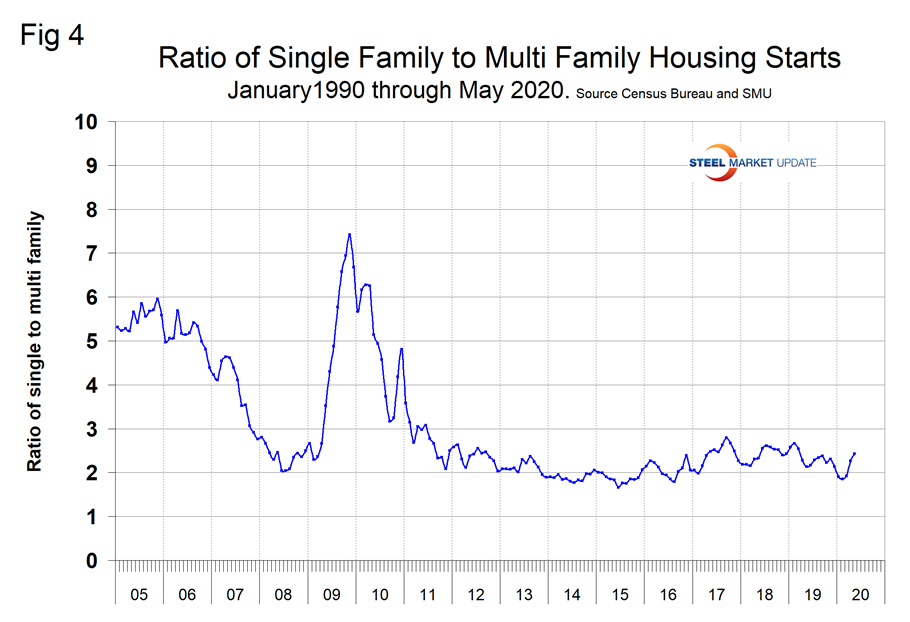
Figure 5 shows total housing starts in four regions with the South being the strongest and the Northeast the weakest. All four regions have suffered major declines this year. The National Association of Home Builders optimism index crashed in April and recovered somewhat in May and June, but the 3MMA shown in Figure 6 continued to decline.
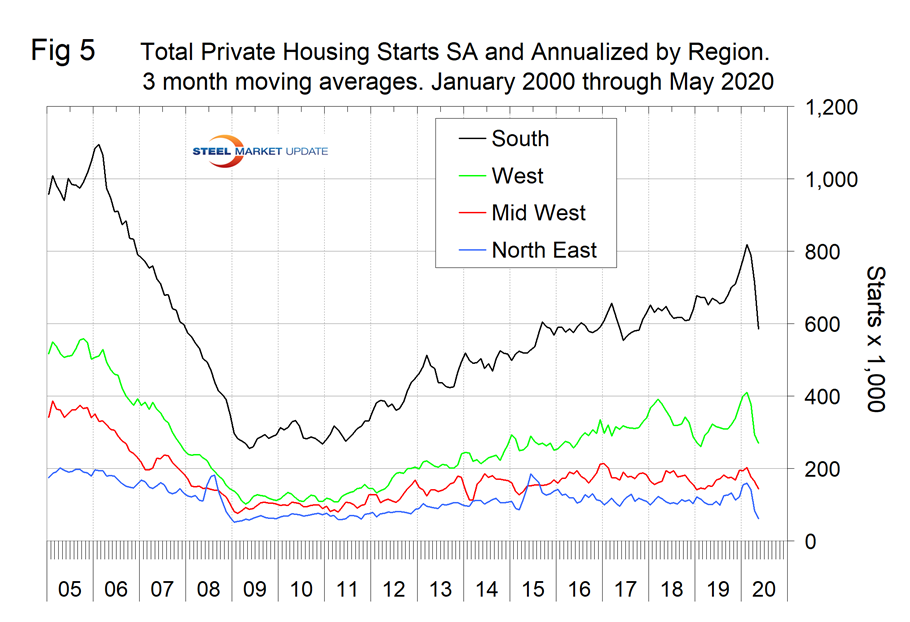
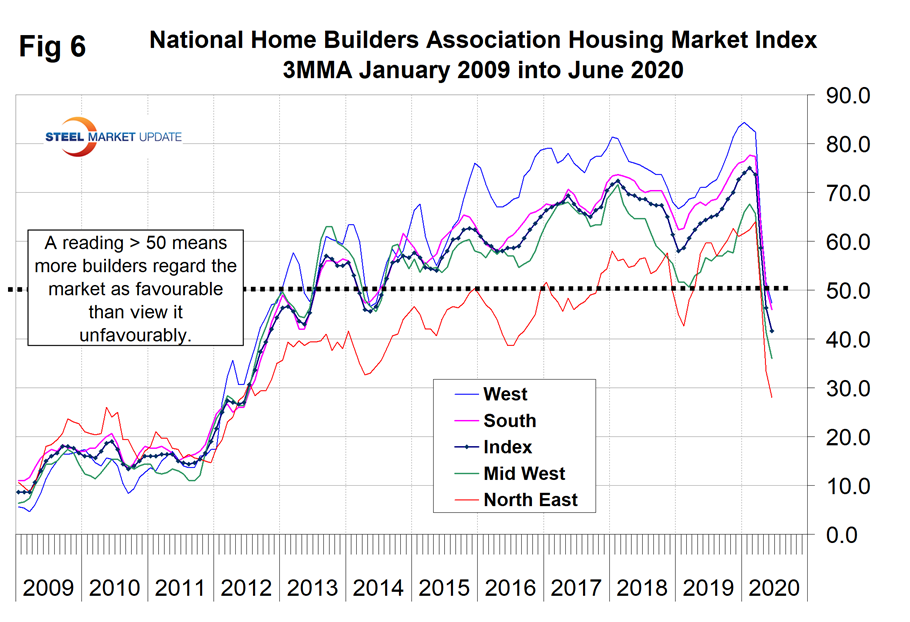
State and Local Construction
Total S&L expenditures recovered more slowly than private work from the last recession and are again showing a delayed reaction as they are holding up better than private expenditures today. This includes both infrastructure and nonresidential buildings. In three months through May, all building sectors except health care had positive growth (Table 3). Educational is by far the largest subsector of S&L nonresidential buildings at $7.1 billion in May and expanded at a 5.5 percent rate in three months through May with negative momentum. Figure 7 shows the history of total S&L expenditures.
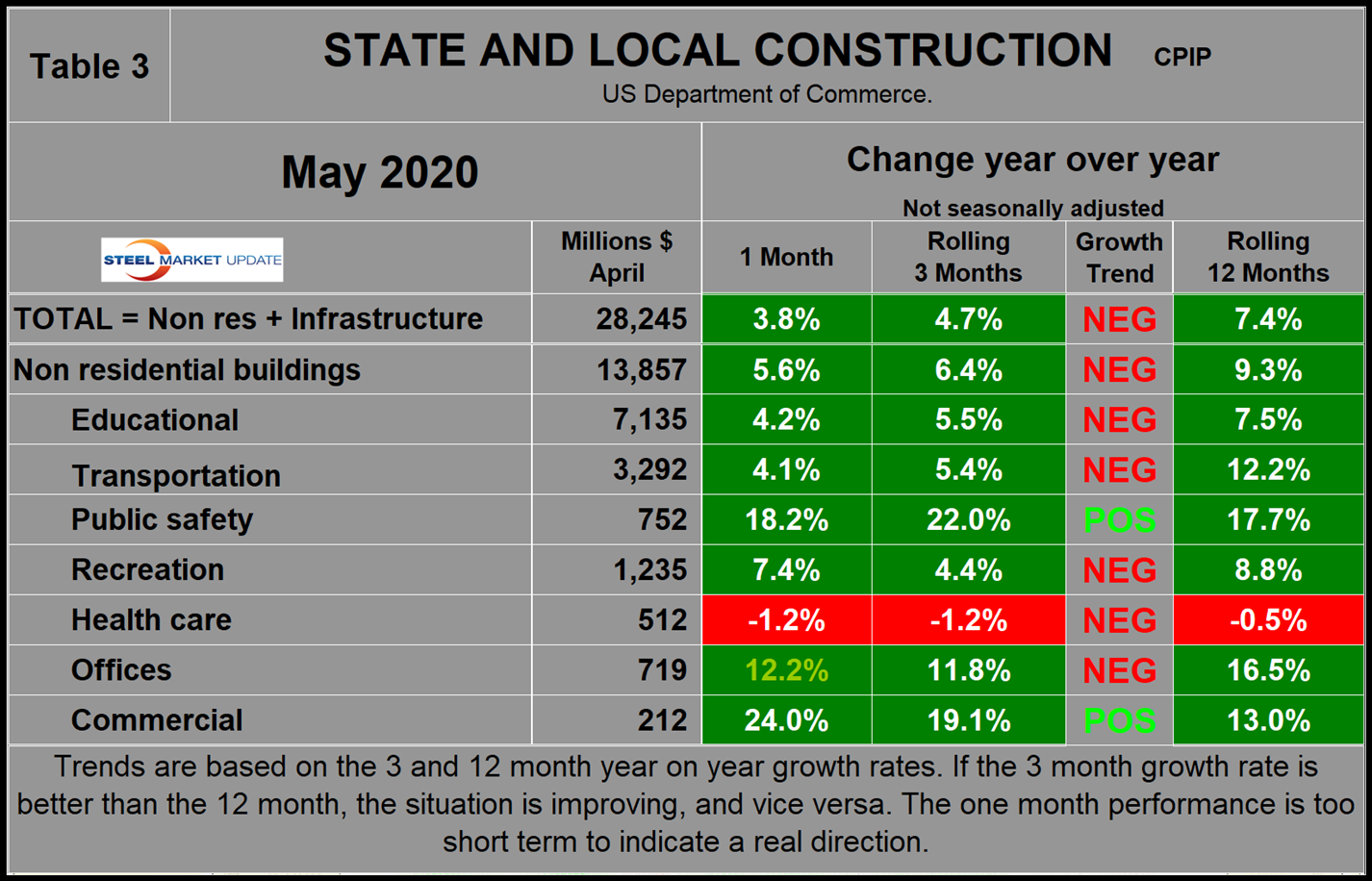
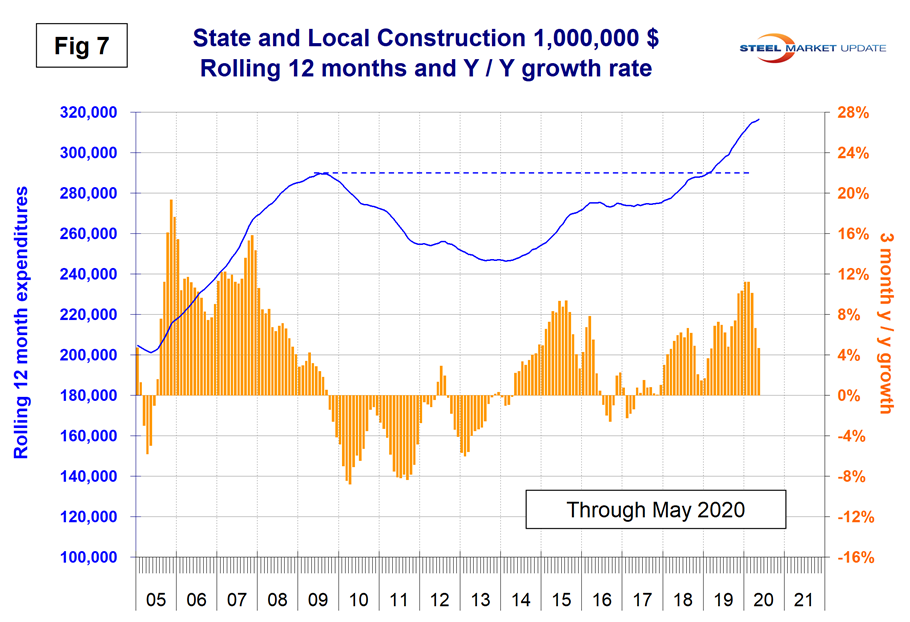
Drilling down into the private and S&L sectors as presented in Tables 2 and 3 shows which project types should be targeted for steel sales and which should be avoided. There are also regional differences to be considered, data for which is not available from the Commerce Department.
Infrastructure
Infrastructure expenditures have had positive growth since January 2019, but growth declined in the months March through May this year. Year over year, the growth of infrastructure expenditures in three months through May was 1.8 percent and on a rolling 12-months basis was 4.1 percent. (Note, there is no seasonality in this report as only year-over-year data is considered.) Highways and streets including pavement and bridges account for almost three quarters of total infrastructure expenditures. Highway pavement is the main subcomponent of highways and streets and had an 8.6 percent growth in three months through May. Bridge expenditures have had a double-digit contraction rate every month since September last year. Table 4 shows the breakdown of infrastructure expenditures in three months and 12 months through May and Figure 8 shows the rolling 12-month history of infrastructure expenditures and the year-over-year growth rate.
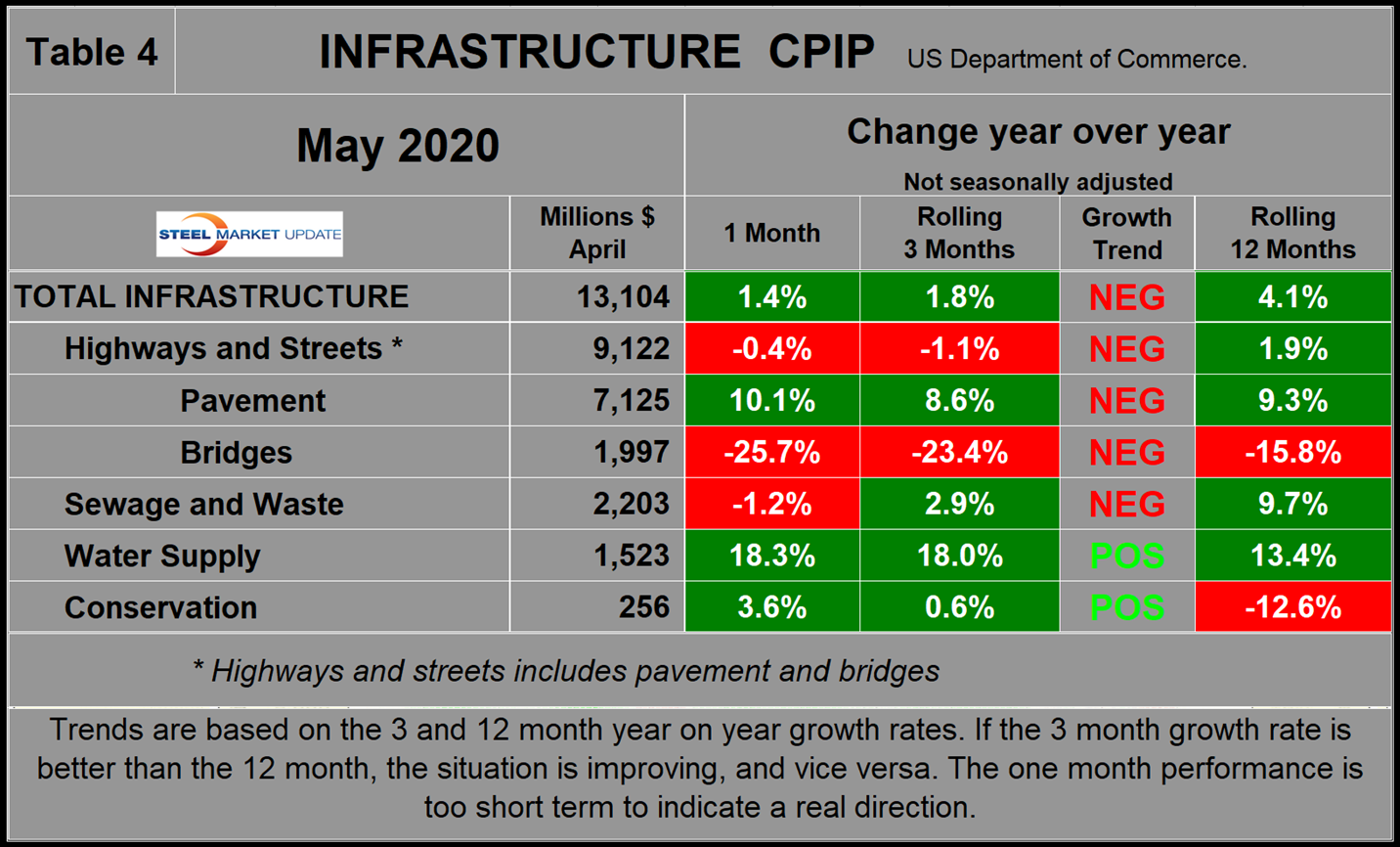
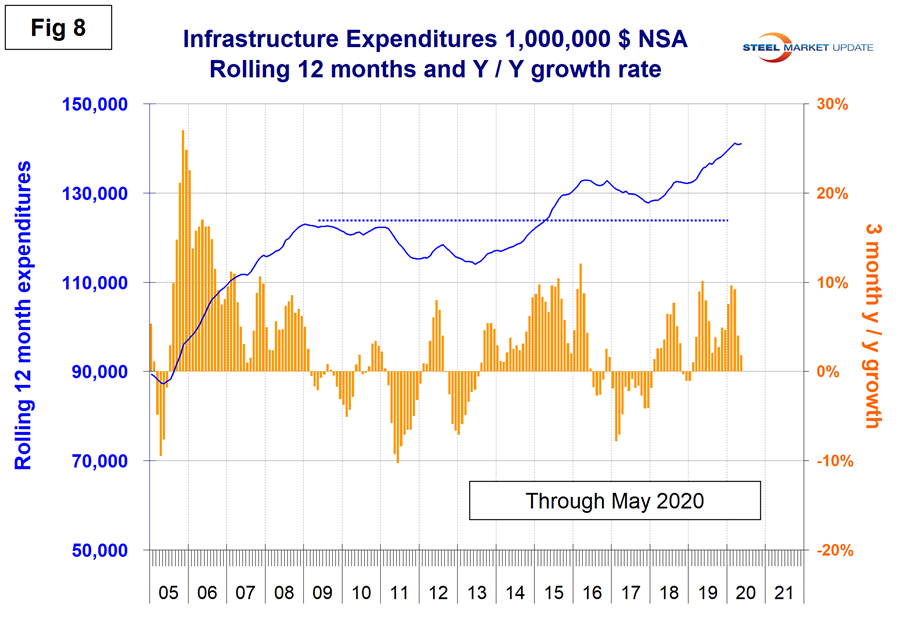
Total Building Construction Including Residential
Figure 9 compares year-to-date expenditures for the construction of the various building sectors for 2019 and 2020. Single-family residential is dominant and in the 12 months of 2019 totaled $274.0 billion, down from $289.6 billion in 2018.
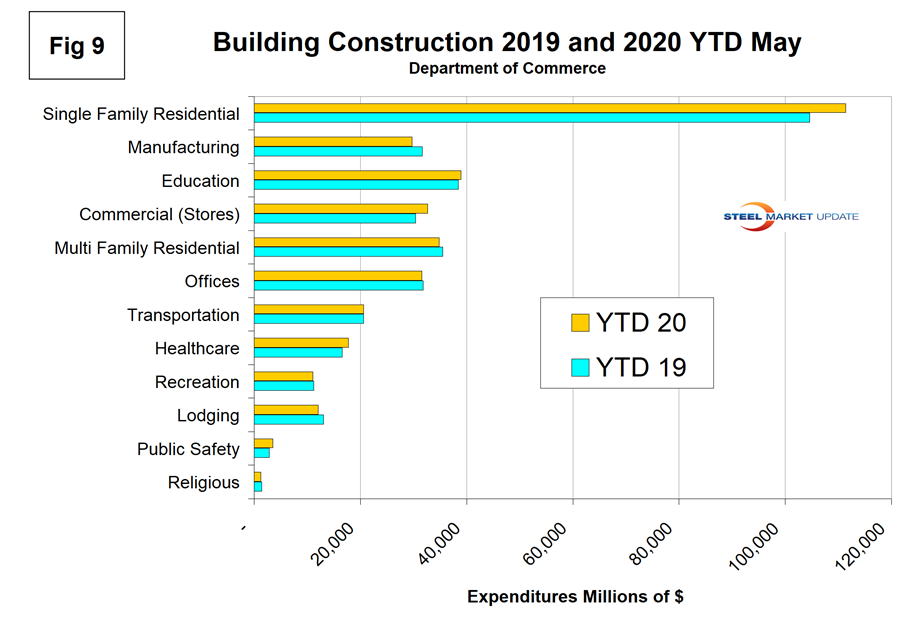
Figure 10 shows total expenditures and growth of nonresidential building construction through May 2020. Growth has slowed every month this year and in May reached negative 1.3 percent. On a rolling 12 months basis, expenditures on nonresidential buildings were at an all-time high in March 2020.
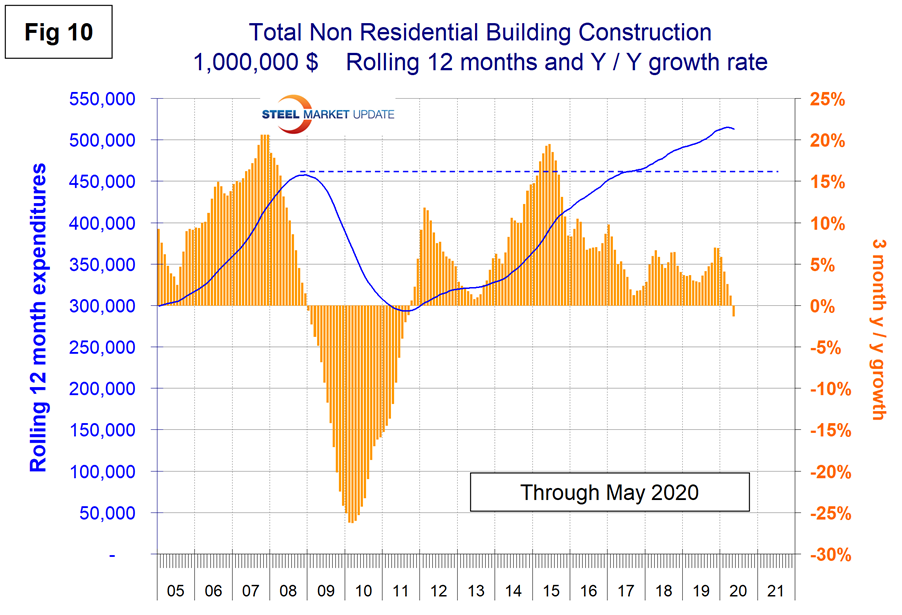
Explanation: Each month, the Commerce Department issues its Construction Put In Place (CPIP) data. There are three major categories based on funding source: private, state and local, and federal. Within these three groups are about 120 subcategories of construction projects. SMU examines the three funding categories to provide a summary of steel-consuming sectors.
CPIP is based on spending work as it occurs and is estimated each month from a sample of projects. In effect, the value of a project is spread out from the project’s start to its completion. This is different from the starts data published by the Census Bureau for residential construction, by Dodge Data & Analytics and by Reed Construction for nonresidential construction, and by Industrial Information Resources for industrial construction. In the case of starts data, the whole project is entered into the database when ground is broken. The result is that the starts data can be very spiky, which is not the case with CPIP.
The official CPIP press release gives no appreciation of trends on a historical basis and merely compares the current month with the previous one on a seasonally adjusted basis. The background data is provided as both seasonally adjusted and non-adjusted. The detail is hidden in the published tables, which SMU tracks and dissects to provide a long-term perspective on the magnitude of growth or contraction of the various sectors. Data on residential improvements is not included in this analysis as such projects are minor consumers of steel.
The four tables included in this analysis present the non-seasonally adjusted expenditures for the most recent data release. Growth rates presented are all year over year and are the rate for the single month’s result, the rolling three months and the rolling 12 months. Single-month year-over-year results are not included as they are preliminary and can contain too much noise. The growth trend columns indicate momentum. If the rolling three-month growth rate is stronger than the rolling 12- month rate, that is viewed as positive momentum, or vice versa. Growth rates cited in the text refer to the rolling three-month year-over-year rate. In Figures 1, 2, 6, 7 and 9, the blue lines represent the rolling 12-month expenditures and the brown bars represent the rolling three-month year-over-year growth rates.

Peter Wright
Read more from Peter WrightLatest in Steel Markets

USW cheers Evraz NA agreement with Atlas Holdings
The United Steelworkers (USW) labor union celebrated recent news of the signed agreement between Atlas Holdings and Evraz NA in which the Connecticut-based private equity company said it plans to acquire North America’s Evraz facilities.

Steel buyer spirits tempered by soft spot market conditions
Steel sheet buyers report feeling bogged down by the ongoing stresses of stagnant demand, news fatigue, tariff negotiations or implementation timelines, and persistent macroeconomic uncertainty.

Hot-rolled coil buyers continue seeking certainty
Steel market participants contend that buyers will remain in “wait-and-see" mode until some market stability is restored.

Latin American steel advocates warn on cheap import flood
Subsidized Chinese steel imports and cheap steel products from Association of Southeast Asian Nations (ASEAN) entering Latin American (LATAM) are threatening the region's steel market.

CRU: Steel prices fall amid global demand weakness
The forceful headwinds bearing down on steel markets across the globe have created demand challenges and sent prices southward. The US, however, challenged the global trend.
